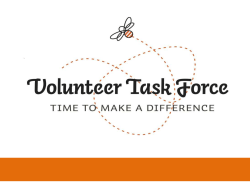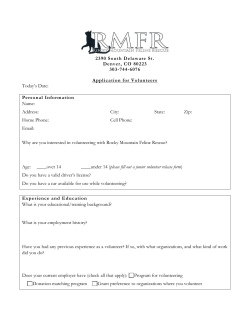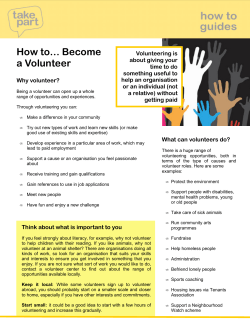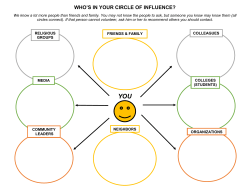
The value of older people`s volunteering
The value of older people’s volunteering Working paper Dan Corry, CEO and Farooq Sabri, Researcher, NPC March 2015 This paper outlines our approach to calculating the value of older people’s volunteering for Decision time, the final report of the Commission on the Voluntary Sector & Ageing. Our approach • Establish the value of an hours volunteering. • Establish the amount of volunteering that older people do now. • Use projected growth of the population to estimate how much more volunteering might be done in aggregate by the older population in 10 and 20 years time. • Turn this into monetary values. Data To make our calculations we need to know the value of volunteering, how much older people volunteer now and the future projections of the number of older people. The value of volunteering For these calculations we use analysis from the speech In giving, how much do we receive? The social value of 1 volunteering by Andy Haldane, Chief Economist at the Bank of England . Page references are to the speech. • There are 15 million volunteers in formal (frequent) volunteering, equating to 1.25 million FTEs. • This amounts to 2 billion hours a year of formal volunteering (p4) and is equivalent to about an hour a week from every person over 16. • Based crudely on the type of jobs done by volunteers etc, this translates into a value of £24bn . • In addition there are 1.7-2.1 billion hours of informal volunteering (p5). • An ONS estimate he cites says that informal volunteering is worth £19bn. 2 1 Haldane, A., In giving, how much do we receive? The social value of volunteering, speech to the Society of Business Economists 9 September 2014 http://www.bankofengland.co.uk/publications/Pages/speeches/2014/756.aspx 2 The methodology is described by Haldane: “value of the labour input used in producing these services, as a proxy for their market value. Specifically, the ONS identifies particular voluntary activities from household surveys and then maps those to paid occupations. Taking the median hourly wage for those occupations, and multiplying by the number of hours volunteers provide, gives an estimate of the volunteering sector’s output on a replacement cost basis” (p8). Note that this does not take into account the opportunity cost of a volunteer not working. 1 We will approximate informal volunteering to 2 million for simplicity. This too represents an additional hour a week from every person over 16, giving us a total of about 2 hours of volunteering (formal and informal) per week from every person over 16. Using these statistics we can say that the value of formal volunteering is on average £12 per hour (£24/2). The value of informal volunteering is slightly less at £9.5 per hour (£19/2). We assume that types of volunteering undertaken by older people are more or less in the same proportion to that of volunteers as a whole, so that these average figures can be applied. We also assume that the value of an hour of volunteering is the same for all ages for the same type of work. 3 As a comparison, the RVS 2011 Gold Age Pensioners report gives for over 65’s values that equate to around £13.50 per hour for formal volunteering (£730.99 worth per year divided by 54.5 hours per year) and £7 for informal volunteering (703.13/104.6)—see sections 3.21-3.25. How much do older people volunteer now? 4 The data below shows % rates of volunteering (at least once a month) in England in 2010/11 —also included in the Commission’s background paper. Age 50-64 65 -74 75 and over All ages Informal 30 33 26 29 Formal 27 31 21 25 This data suggests that the number of hours of informal volunteering for the 65-74 age group is higher than the average for all ages. For the 75+ group there is a drop compared to all ages (although of course this may hide a major drop at a specific age in the range, like 85). On formal hours it suggests that the 65-74 age group do a good deal more than the overall average, but that the over 75’s do a good deal less. Overall, this gives no particular reason for assuming that volunteering rates for the over 65s group as a whole should very different from the average for all ages and hence we can use Haldane’s overall calculations that currently we have about an hour a week per person in both formal volunteering and informal volunteering. If we use Haldane’s assumption that people are doing approximately an hour a week formal volunteering and the same on informal volunteering then we can turn the increased numbers of older people into hours of extra volunteering quite easily. (Note that the estimate of formal hours is very similar to that of RVS but the informal estimate from Haldane is about half of the RVS estimate. So if anything we are being conservative by using Haldane’s figure). 3 Royal Voluntary Service (2011) Gold Age Pensioners report, Valuing the social-economic contributions of older people in the UK, Appendix 1: Economic Model. http://www.royalvoluntaryservice.org.uk/Uploads/Documents/gold_age_ecconomic_2011.pdf 4 Department for Communities and Local Government (2011) Citizenship Survey: April 2010 - March 2011. http://webarchive.nationalarchives.gov.uk/20120919132719/http://www.communities.gov.uk/publications/corporate/statistics/citizenshipsurv eyq4201011 2 The number of older people 5 The data used here is from the ONS and is for England only. (in thousands) Age 60-74 65 and over 75 and over 2013 2023 2033 7,955 9,303 4,285 8,990 11,320 5,781 10,322 14,061 7,312 2013-2023 increase 1,035 2,017 1,496 % increase 13 22 35 2013-2033 increase 2,361 4,578 3,027 % increase 23 51 71 Calculations Using the figures above that half of volunteer hours are formal volunteering (valued at £12 per hour) and half are informal (valued at £9.5 per hour), we have an average value per hour of volunteering of £10.75. We also assume people do two hours (one formal, one informal) a week for 52 weeks: In 2013, the value of volunteering by the over 65s was £10.4bn. 9,303 million x 52 x £10.75 x 2 Now to look at the potential increase over the next two decades. Multiplying by 52 (the number of weeks in a year), the increase in the relevant population and the average number of hours of volunteering per week (informal and formal) gives us the total number of volunteering hours as shown in the table. This shows the potential for substantial increase in volunteer hours overall, which has value even before we turn it into a monetary value. If we again use the average value per hour of volunteering of £10.75, we get the numbers in the table below: Thousands Increase in population 60-74 65 and over 75 and over 1,035 2,017 1,496 2013-2023 Increase in number of hours overall 107,640 209,768 155,584 Value £ Increase in population 1,157,130 2,255,006 1,672,528 2,361 4,758 3,027 2013-2033 Increase in number of hours overall 245,544 494,832 314,808 Value £ 2,639,598 5,319,444 3,384,186 If we assume that the rates of volunteering remain the same, then: In 2023, the value of volunteering by over 65s would be £12.66bn—an increase of £2.26bn or 22%. In 2033, the value of volunteering by over 65s would be £15.72bn—an increase of £5.32bn or 51%. For comparison, RVS estimated the value of older people’s volunteering in the UK at £10.6bn in 2010, with a rise to £14.5bn by 2020—an increase of around £4bn. The RVS methodology is rather different, using a bespoke survey. As noted above their estimates of the value of an hours volunteering are not that different from those used here. However, their estimate of around 2 hours per person over 65 in terms of informal volunteering is higher than that used by Haldane and which we use here. 5 ONS (2013) 2012-Based National Population Projections. Available at: http://www.ons.gov.uk/ons/rel/npp/national-populationprojections/2012-based-projections/rft-table-a1-4-principal-projection---england-summary.xls 3 Summary These figures demonstrate the potential that the growing older population offers in terms of volunteering time for charities. It also highlights what the charity sector will miss out on if it fails to prepare for the demographic changes ahead. It is also almost certainly an underestimate of what the sector could obtain from volunteering from older people. If the sector does respond and adapt in ways the Commission describes, volunteering rates could be higher than we have assumed and so the ‘value’ of volunteering could also be higher. Finally, we should note that here we have only counted what Haldane calls the “economic” value of the goods and services created by volunteers and not other aspects that he goes on to consider like the private value (benefits to the volunteer of volunteering in terms of well-being, health etc) and the social value (the benefit of the social action that the volunteering achieves) although in this case there are issues that Haldane’s calculations may be doing some double counting. The Commission on the Voluntary Sector & Ageing was established by NPC and ILC-UK in 2013 to consider future population trends and explore strategically how the charity sector can best prepare for and adapt to an ageing society over the next 20 years. You can find out more about our work and download our final report at www.voluntarysectorageing.org. We welcome your thoughts and feedback, so get in touch via volsecageing@thinknpc.org or on Twitter @VolSecAgeing. We are grateful for the support of our funders. The Commission has been funded in its first year by the National Lottery through the Big Lottery Fund and by Prudential. 4
© Copyright 2025









